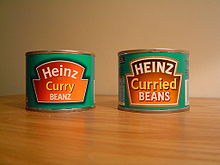Baked beans

Baked beans is a dish consisting of beans baked (or, despite the name, usually stewed) in a sauce.
Traditional cuisines of many regions claim such recipes as typical specialities, for example:
- Jersey bean crock
- Boston baked beans
- Guernsey bean jar
- Cassoulet
- Feijoada
- New England baked beans
- Quebec-style baked beans are often prepared with maple syrup.
- Bean-hole beans, traditionally from Northern New England and Quebec, cooked in a covered fire pit in the ground for up to two days
- British cuisine claims beans on toast as a teatime favourite, and baked beans may form part of a full English breakfast
- Beans cooked in barbecue sauce (or a similarly flavoured sauce) are a traditional side-dish in a United States barbecue.
- "Frank and beans", a recipe where hot dogs are cut up and cooked in the same sauce as the baked beans. Also referred to as "Beanee Weenee", the brand name under which it is sold by Van Camp's.
Most commercial tinned baked beans such as Heinz are made from haricot beans, also known as Boston Beans or Navy Beans, a variety of Phaseolus vulgaris, and sold in a sauce. In the United Kingdom, tomato sauce is most commonly used. A similar dish is Pork and Beans.
The popularity of baked beans may be due to the fact they are cheap to make and buy. British supermarkets may sell store brand baked beans for less than twenty pence a tinned can[1] (Baked beans are a classic example of a "loss leader", a product sold by supermarkets for an abnormally low price, often less than cost. This is done because some products are thought by marketeers to be widely used as benchmarks by consumers to judge how cheap a supermarket is, or simply to boost the sales of complementary products. Another example of a typical loss leader is white sliced bread), but some premium organic brands may be as expensive as £1.50.[2] Baked beans have recently begun appearing in conjunction with other foods, such as a filler inside sausages, as a sidedish with bacon, or as a pizza topping.
History

According to alternative traditions, sailors brought cassoulet from the south of France, or the regional bean stew recipes from northern France and the Channel Islands.
Most probably, a number of regional bean recipes coalesced and cross-fertilised in North America and ultimately gave rise to the baked bean culinary tradition familiar today.
The Heinz company markets their product in the UK under the name "Baked Beanz", in reference to a 1960s advertisement campaign which used the slogan "Beanz Meanz Heinz".
Regional variations
In the United Kingdom, Heinz is the top selling brand of baked beans. There are substantial differences between the Heinz baked beans sold in the UK and the nearest equivalent U.S. product (Heinz Premium Vegetarian Beans). The U.S. beans contain brown sugar where the British beans do not. The U.S. product contains a total of 14g of sugar per can compared to 7g for the British version (equating to 140 vs 90 calories per tin). The U.S. beans also possess a mushier texture and are darker in colour than their UK counterpart.
Heinz Beans were first sold in the UK in the upmarket Fortnum & Mason store in London as an exotic import (and were sold at a high price). Although now a staple food, and possibly a downmarket one, the store continues the tradition of selling Heinz Beans among its more expensive wares.
In the United States, Bush's is the top producer of baked beans, and the company produces several flavours. Most of these products are in a very sweet sauce with little tang. By comparison, home made baked beans are considerably tangier.
In New England baked beans usually are sweetened with maple syrup, and are traditionally cooked with salt pork in a beanpot in a brick oven for a full day. A popular and widely available brand of New England or Boston baked beans is B&M's Original Baked Beans[3].
In southern states along the eastern seaboard of the US, the beans become tangier usually due to the addition of yellow mustard. Ground beef also becomes common alongside bacon in these beans. They take on a flavor similar to Cowboy Beans, a similar popular dish.
Many unusual dishes are made with baked beans including "cold bean sandwiches". These are slices of bread topped with beans and melted cheese.
Health
In 2002 the British Dietetic Association allowed manufacturers of canned baked beans to advertise the product as contributing to the recommended five daily allowance of vegetables per person. This concession was criticised by heart specialists who pointed to the high levels of sugar and salt in the product. Some manufacturers produce a "healthy option" version of the product with lower levels of sugar and salt.
